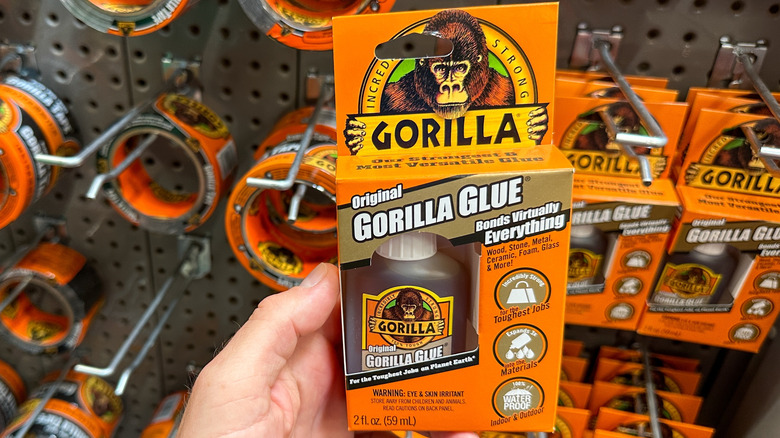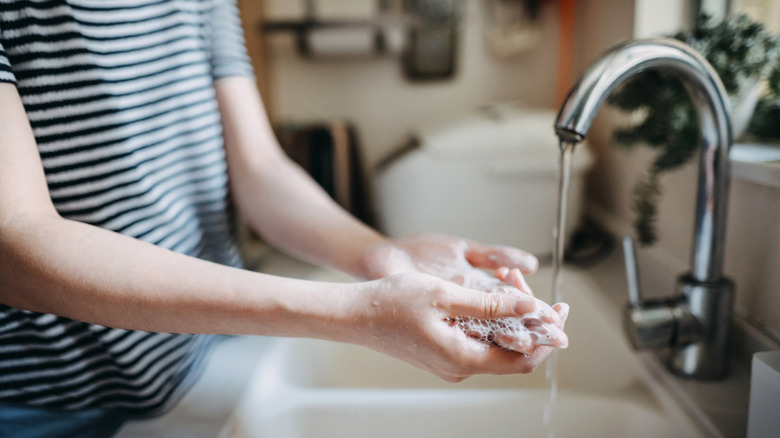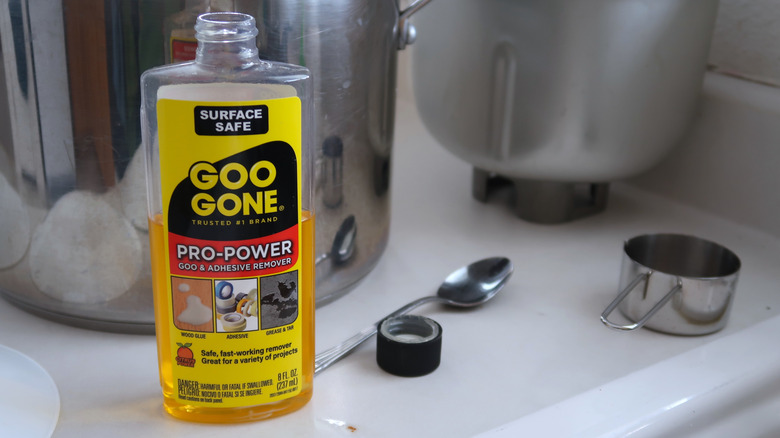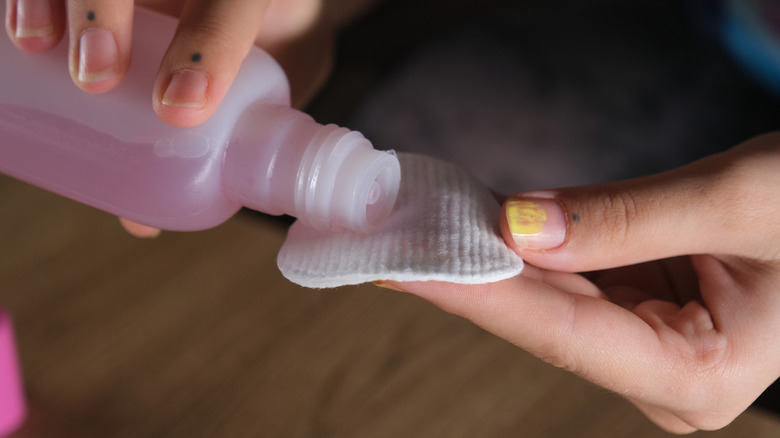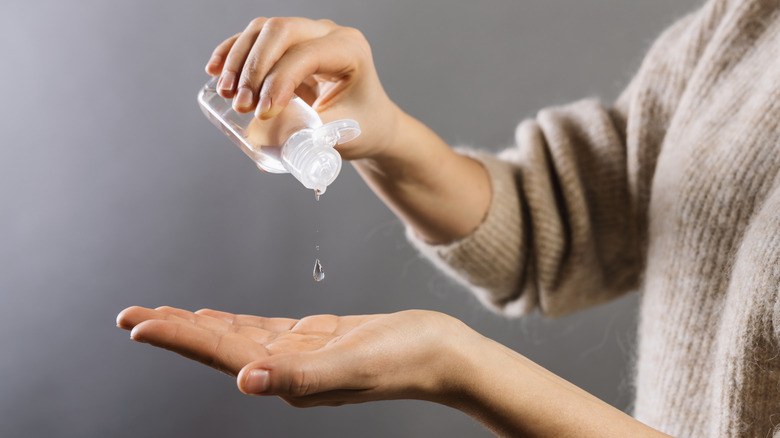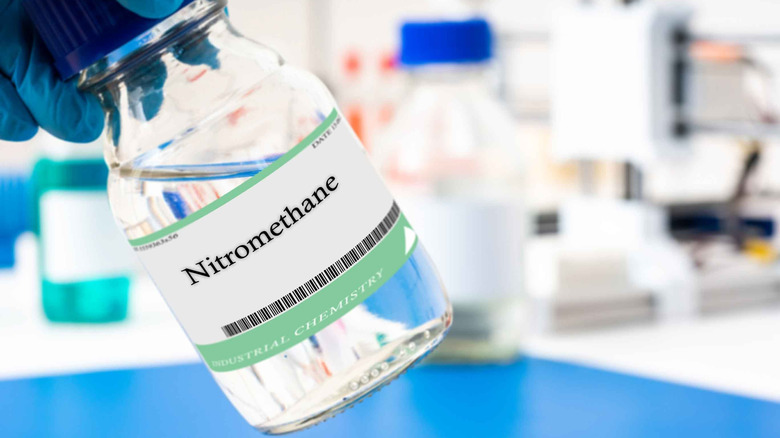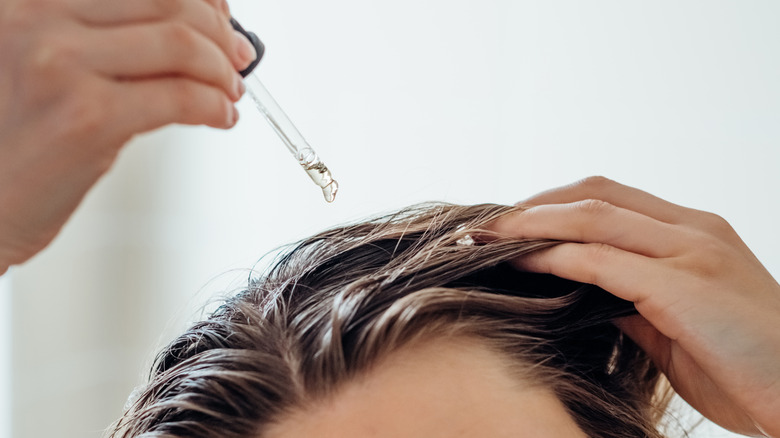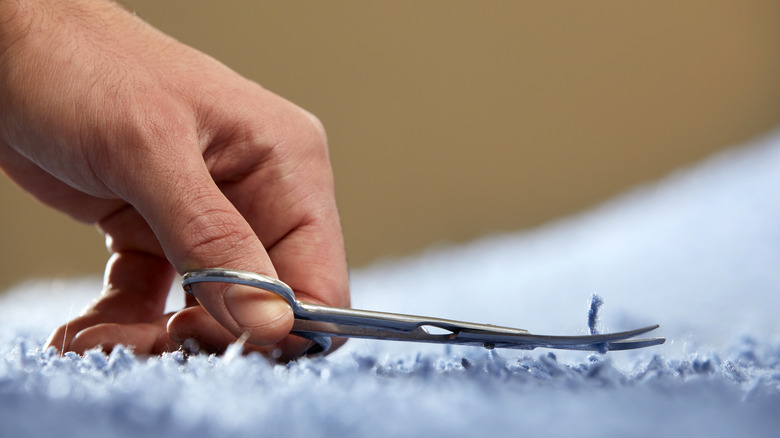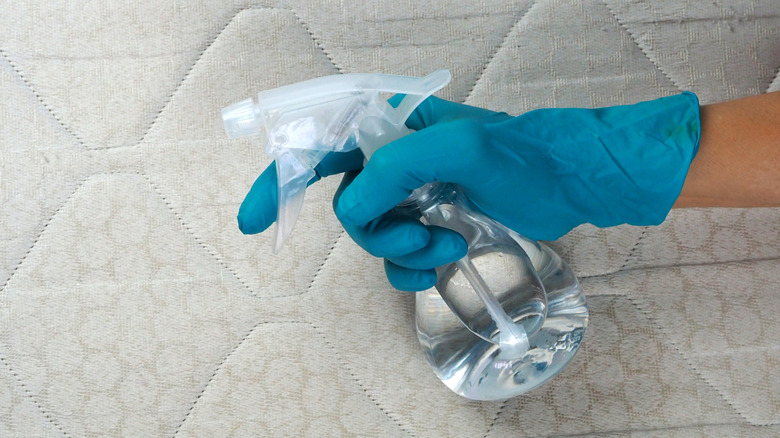The 9 Best Ways To Remove Dried Gorilla Glue From Skin And Other Surfaces
We may receive a commission on purchases made from links.
Whether repairing a kitchen cabinet, constructing a birdhouse, or fixing a broken picture frame, chances are your project benefits from using Gorilla Glue. It ranks among the best types of glue you should have on hand for home and garden upkeep as it's one of the strongest adhesives on the market. Gorilla Glue is an affordable solution to a variety of tasks, as it creates a long-lasting bond and can be used on a wide range of surfaces. One of the most common mistakes everyone makes when using Gorilla glue around the house is applying too much, which can lead to the glue getting on your skin, clothing, kitchen countertop, or living room carpet. Since the glue hardens quickly, removing it can be quite challenging.
While many methods can be utilized to remove Gorilla Glue after it has hardened, not all are safe for skin, fabric, or plastic surfaces. That is because some of these removal options require harsh chemicals that may irritate sensitive skin, discolor clothing items, or dissolve objects made of plastic. The best way to tackle excess dried Gorilla Glue from spills and other mishaps is to implement safe, effective, and practical techniques that gently break the bond of the glue, resulting in clean surfaces that are free of damage.
Use an exfoliating soap to remove Gorilla Glue from skin
Gorilla Glue recommends using gloves when working on any project; however, it provides a solution if you get some of the glue on your skin. The company advises using an exfoliating soap with a gritty texture and cold water to successfully lift the adhesive. Wet the area of your skin that has come into contact with Gorilla Glue. Rub the soap directly on the target point until it lathers, or grab a gentle exfoliator to work in the product. Depending on how much glue you have on your skin, you may need to repeat this a few times. Once the glue has been removed, rinse the area.
The method works because the exfoliating soap can help soften and physically rub off the adhesive. An exfoliator or a soap with a gritty texture (like Lava Heavy-Duty Hand Cleaner) is a better household mainstay for removing Gorilla Glue from the skin versus other options, such as acetone. Exfoliating soaps contain abrasive particles that can help dislodge the glue without harming your skin. Of course, you'll still need to make sure you don't scrub too hard, or some irritation may occur. It's also best to apply a moisturizing lotion immediately after removing the glue with an exfoliant to keep your skin from drying out.
Apply Goo Gone to release Gorilla Glue from stone and quartz countertops
In the event that you spill a little Gorilla Glue on a stone or quartz countertop, you'll need to take extra care in how you remove it so you don't end up damaging the surface. Solvents like acetone can work for removing glue from granite countertops, but they can be harsh on the finish. If you're looking for a gentler (but still effective) option, you might want to try Goo Gone Spray Gel. Spray the gel directly over the glue. Make sure you have fully coated it, then wait for five minutes. Grab an old rag and wipe everything off. If any stubborn glue remains, you should be able to scrape it with the edge of a firm card. Clean the countertop afterward using hot water with a drop of liquid dish soap.
Goo Gone Spray Gel can quickly loosen Gorilla Glue from countertops, as it can quickly break down the glue, eliminating the need for elbow grease, and potential scratching from too much scrubbing. Abrasive scrub brushes and scrapers can also damage stone countertops, so they should be avoided. At the same time, Goo Gone is less harsh than a pure solvent like acetone, therefore, there is less chance of it damaging the surface. To be safe, though, it's always best to test the Gloo Gone on an inconspicuous area of the countertop before you use it to remove the glue. Additionally, be sure to reseal the area of your countertop if it looks like the Gloo Gone has removed the sealant. To protect your countertop in future, cover the area with a crafting mat before you begin working on your project.
Grab some acetone to remove dried Gorilla Glue from glass
While acetone isn't the best option for lifting Gorilla Glue from skin and sensitive surfaces like plastic, it is a potentially viable choice for cleaning glue off of glass. You can use either a can of acetone or a nail polish remover made of 100% acetone. Grab an old rag and pour the acetone directly over the glue (or dab it on if the glue is on a vertical glass surface). You only need enough to completely coat the glue spot. Use the rag to cover the area where Gorilla Glue sits on the glass. Wait 30 seconds before wiping away the mixture. Wash and shine the glass as you normally would.
Acetone works by breaking down the chemical bonds that keep the glue adhered to the glass. It's affordable and readily available, so chances are you already have a bottle in your home. Because glass is inert and does not react with acetone, you can safely clean it with this solvent. However, be aware that the acetone can damage certain films. For instance, do not apply acetone to windows that have tinted films, as it could dissolve the film or the adhesive that's holding it in place. Acetone can also damage things like rubber seals and vinyl frames around windows, as well as paint finishes. So, use it with care and try to only get it on the glass you're "de-glueing," not on any materials surrounding it.
Get stubborn Gorilla Glue off your hands with rubbing alcohol
Sometimes, it's easier to be precise when working on a project if you're operating with your bare hands. Unfortunately, that leaves them susceptible to coming into contact with the glue. If you can't get the Gorilla Glue off your hands using the exfoliating soap and warm water, rubbing alcohol is your best bet. Soak a cotton ball in 70% rubbing alcohol and then rub it over the glue on your hands. Repeat until all the glue has been lifted. Wash your hands with soap and warm water to rinse off all traces of the rubbing alcohol.
Rubbing alcohol is highly affordable and versatile, so chances are you already have this item in your cabinet. It doesn't contain any harsh chemicals, which makes it safe for use on hands and a better option than acetone or Goo Gone. The pantry staple is a polar protic solvent, and it works by dissolving the polar molecules of the glue. The fact that you can even use rubbing alcohol to remove dried super glue from your hands is a testament to its glue-busting power. The only downside is that rubbing alcohol can leave your hands feeling dry. To combat this, apply a moisturizing hand lotion after the glue has been removed.
Apply nitromethane to release Gorilla Glue from plastic surfaces
Accidentally spilt Gorilla Glue on a plastic item or surface? Many chemicals that remove this type of glue can also damage plastic. The good news is that nitromethane (aka racing car fuel) is safe to use on plastic, and used to appear in a variety of debonding products. All you have to do is pour a nitromethane debonding solution over a cotton ball. Set the cotton ball on the glue and wait a few seconds. Then, begin blotting until you have eliminated the glue. Rinse the plastic with warm, soapy water, and you're good to go.
Nitromethane is the best option for this task versus a solvent-based product or acetone, as it is a gentler debonding agent that doesn't eat away at plastic, yet is still strong enough to break down dried glue. The bad news is that nitromethane is pretty hard to get hold of. You won't find it at your local grocery or department stores, and most debonding agents don't seem to use it in their formulas anymore — and instead contain acetone. The best place to look for this useful but elusive product is probably in hobby stores. Because nitromethane is a flammable fuel, don't use it near heat or open flames.
Use moisturizing body oil to loosen Gorilla Glue from skin and hair
Whether you accidentally get glue in your hair or on the hairy areas of your arms, you'll want to tackle the removal with care. Moisturizing body oils that contain isopropyl myristate work to gently remove Gorilla Glue from skin and hair without causing breakage. Pour your preferred oil over the glue and rub it in with your fingers. After about 10 to 30 seconds, the glue should loosen its hold. Finish up by washing your skin with soap and water or your hair with shampoo and conditioner.
Isopropyl myristate is one of the main ingredients in makeup removers, so if you have any on hand, you may want to try them before spending money on a moisturizing body oil. Alternatively, if you work with glue a lot and want to have a dedicated remover around that's gentle enough for skin and hair, you can pick up a bottle of something like the Black Lagoon Isopropyl Myristate Professional Makeup and Adhesive Remover. The chemical itself does a great job of breaking the bonds of the glue so you can quickly work it out of your hair. Exfoliating soap may damage hair, while products like acetone or rubbing alcohol may severely dry it out, making the isopropyl myristate body oil a better choice.
Use salt to remove dried Gorilla Super Glue from your fingers
Gorilla Super Glue sets so quickly, it can easily adhere to your fingers, and even glue them together. If this happens, there's no need to panic. Just head to your spice cabinet and grab salt. Sprinkle the salt in the spaces where your fingers stick to one another, making sure it reaches the affected area. Place your fingers in a bowl of water and try to rub them together. You'll need to repeat the use of salt and water a few times to dissolve the glue. Besides leveraging this method to set stuck-together fingers free from super glue, you can also try using it to remove regular Gorilla Glue from areas of your skin.
Why is salt the secret to getting dried glue off your fingers? Well, salt works much the same way as exfoliating soap. It's a better choice for fingers stuck together because you can pour the salt directly over the glue, ensuring contact, whereas the gritty part of the exfoliating soap may have trouble reaching the glue (but you may need to press the salt in a bit to ensure it touches the surface of the glue). Salt is also readily available, right in your pantry, perfect for emergency glue removal.
Although it is not a solvent, salt can still leave your skin feeling dry. Apply a hand moisturizer over your fingers once set free and properly washed and dried. One crucial detail you should know before working with Gorilla Glue is that it can cause contact dermatitis, which can be painful and itchy. This is one of the reasons why wearing gloves and keeping exposed skin covered is recommended.
Mechanically remove dried Gorilla Glue from fluffy carpeting
When removing Gorilla Glue from carpeting, you'll need to shift your focus from dissolving or loosening the grip of the glue to mechanically cutting it out. Start with a pair of tweezers and begin picking at the glue to chip away as much as you can. Once you've removed all the glue that is willing to come up, grab a pair of scissors and carefully trim away the carpet fibers that still have pieces of Gorilla Glue stuck to them. Use a carpet cleaner to refresh the area and restore it to its previous glory.
Unfortunately, many of the solvents that release Gorilla Glue from most surfaces have the power to damage or discolor carpeting, leaving mechanical removal as the safest option. It's important to note that if you are too generous with your cuts, you'll end up with a bare spot on your rug, so take your time and use caution as you go. You'll also want to make sure you're using sharp scissors, as dull cuts can leave carpet fibers frayed and unsightly. If you're dealing with a very short low pile rug that's impossible to trim in this way, you can resort to trying to dissolve the glue with a solvent like acetone, but be sure to test it out on an inconspicuous area to check that it won't damage or discolor the rug.
Use the acidic power of vinegar to remove glue from clothing
Perhaps the Gorilla Glue spill missed your hand and landed on the sleeve of your sweater. Fabric surfaces need to be treated with care, as similar to carpeting, they can easily be discolored or frayed. The best option is to use white distilled vinegar, which many homemakers already employ when laundering clothing items. Pour the vinegar on a rag and scrub the affected area. Since vinegar doesn't typically stain clothing, you can also pour it directly over the glue, let it sit for 30 seconds, and scrub it with the rag. Once the glue has been successfully removed, wash the clothing item as you normally would.
Acetone can be tough on clothing, making vinegar a better option. The acetic acid in the vinegar solution should help to break down the glue. Full strength acetic acid has been found effective at dissolving polyurethane adhesives in recycling applications. However, as household vinegar only contains around 5% acetic acid, this method will probably work best if the glue hasn't dried yet. For glue that has dried, you may need to carefully tackle the mark with some acetone on a cotton bud. But like with carpets, test for color changes on an inconspicuous spot of the garment first. Alternatively, you could try using cleaning-strength vinegar that contains a higher percentage of acetic acid (such as this Natural Elements 30% Vinegar from Amazon). While it's a favorite with dry cleaners, just do a spot test first, especially on colorful fabrics. Finally, consider wearing an artist's smock when working on any projects that utilize the power of Gorilla Glue. This is an excellent way to prevent your favorite clothing item from becoming a victim of DIY work.
